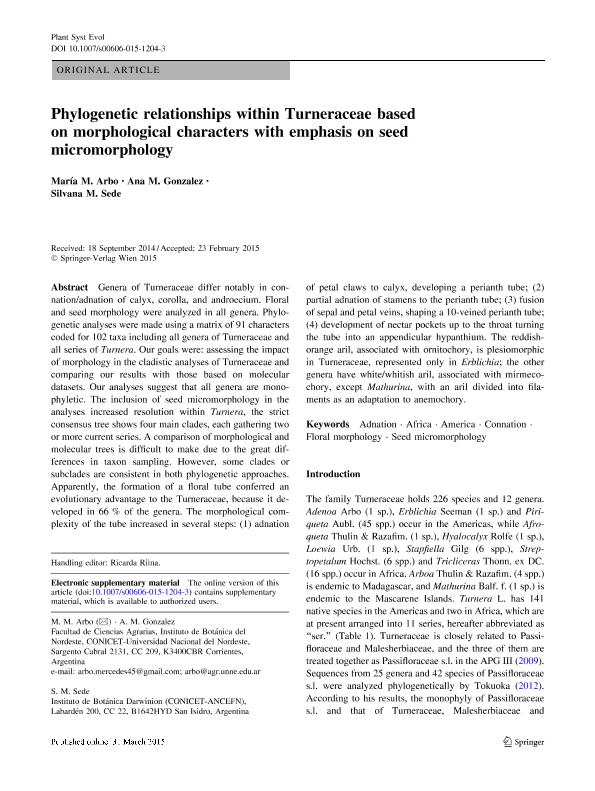Mostrar el registro sencillo del ítem
dc.contributor.author
Arbo, Maria Mercedes

dc.contributor.author
Gonzalez, Ana María

dc.contributor.author
Sede, Silvana Mabel

dc.date.available
2016-01-06T16:38:09Z
dc.date.issued
2015-08
dc.identifier.citation
Arbo, Maria Mercedes; Gonzalez, Ana María; Sede, Silvana Mabel; Phylogenetic relationships within Turneraceae based on morphological characters with emphasis on seed micromorphology; Springer Wien; Plant Systematics and Evolution; 301; 7; 8-2015; 1907-1926
dc.identifier.issn
0378-2697
dc.identifier.uri
http://hdl.handle.net/11336/3384
dc.description.abstract
Genera of Turneraceae differ notably in connation/adnation of calyx, corolla, and androecium. Floral and seed morphology were analyzed in all genera. Phylogenetic analyses were made using a matrix of 91 characters coded for 102 taxa including all genera of Turneraceae and all series of Turnera. Our goals were: assessing the impact of morphology in the cladistic analyses of Turneraceae and comparing our results with those based on molecular datasets. Our analyses suggest that all genera are monophyletic. The inclusion of seed micromorphology in the analyses increased resolution within Turnera, the strict consensus tree shows four main clades, each gathering two or more current series. A comparison of morphological and molecular trees is difficult to make due to the great differences in taxon sampling. However, some clades or subclades are consistent in both phylogenetic approaches. Apparently, the formation of a floral tube conferred an evolutionary advantage to the Turneraceae, because it developed in 66 % of the genera. The morphological complexity of the tube increased in several steps: (1) adnation of petal claws to calyx, developing a perianth tube; (2) partial adnation of stamens to the perianth tube; (3) fusion of sepal and petal veins, shaping a 10-veined perianth tube; (4) development of nectar pockets up to the throat turning the tube into an appendicular hypanthium. The reddish-orange aril, associated with ornitochory, is plesiomorphic in Turneraceae, represented only in Erblichia; the other genera have white/whitish aril, associated with mirmecochory, except Mathurina, with an aril divided into filaments as an adaptation to anemochory.
dc.format
application/pdf
dc.language.iso
eng
dc.publisher
Springer Wien

dc.rights
info:eu-repo/semantics/openAccess
dc.rights.uri
https://creativecommons.org/licenses/by-nc-sa/2.5/ar/
dc.subject
Adnation
dc.subject
Africa
dc.subject
America
dc.subject
Connation
dc.subject
Floral Morphology
dc.subject
Seed Micromorphology
dc.subject.classification
Ciencias de las Plantas, Botánica

dc.subject.classification
Ciencias Biológicas

dc.subject.classification
CIENCIAS NATURALES Y EXACTAS

dc.title
Phylogenetic relationships within Turneraceae based on morphological characters with emphasis on seed micromorphology
dc.type
info:eu-repo/semantics/article
dc.type
info:ar-repo/semantics/artículo
dc.type
info:eu-repo/semantics/publishedVersion
dc.date.updated
2016-03-30 10:35:44.97925-03
dc.journal.volume
301
dc.journal.number
7
dc.journal.pagination
1907-1926
dc.journal.pais
Austria

dc.journal.ciudad
Viena
dc.description.fil
Fil: Arbo, Maria Mercedes. Consejo Nacional de Investigaciones Científicas y Técnicas. Centro Científico Tecnológico Nordeste. Instituto de Botánica del Nordeste (i); Argentina
dc.description.fil
Fil: Gonzalez, Ana María. Consejo Nacional de Investigaciones Científicas y Técnicas. Centro Científico Tecnológico Nordeste. Instituto de Botánica del Nordeste (i); Argentina
dc.description.fil
Fil: Sede, Silvana Mabel. Consejo Nacional de Investigaciones Científicas y Técnicas. Instituto de Botánica Darwinion; Argentina
dc.journal.title
Plant Systematics and Evolution

dc.relation.alternativeid
info:eu-repo/semantics/altIdentifier/doi/http://dx.doi.org/10.1007/s00606-015-1204-3
dc.relation.alternativeid
info:eu-repo/semantics/altIdentifier/url/http://link.springer.com/article/10.1007/s00606-015-1204-3
Archivos asociados
